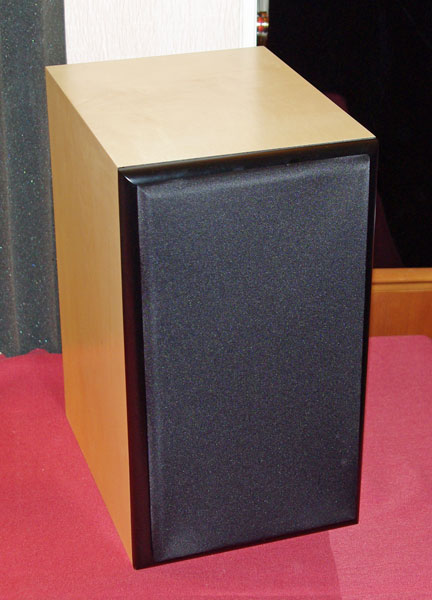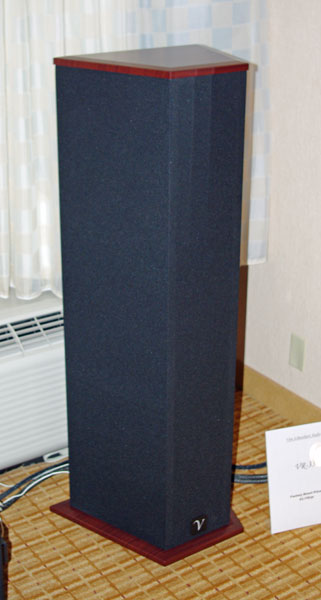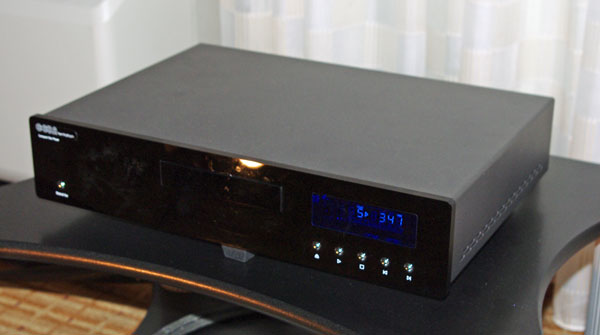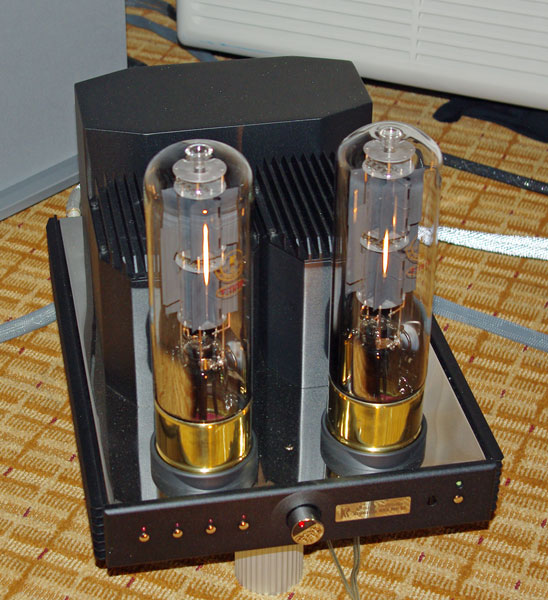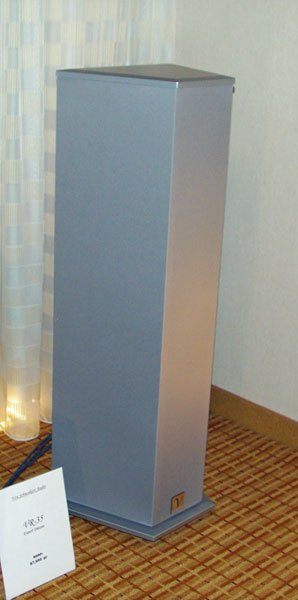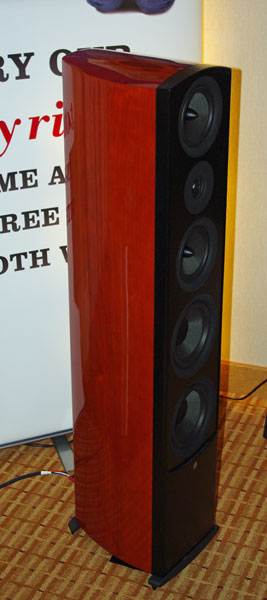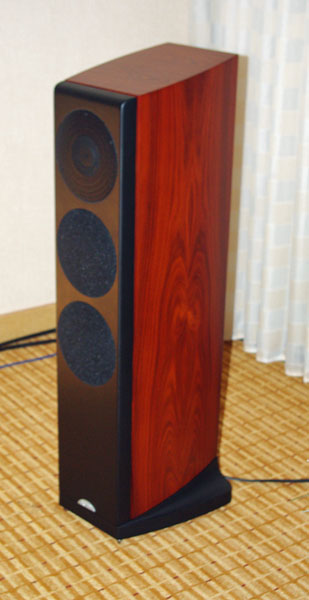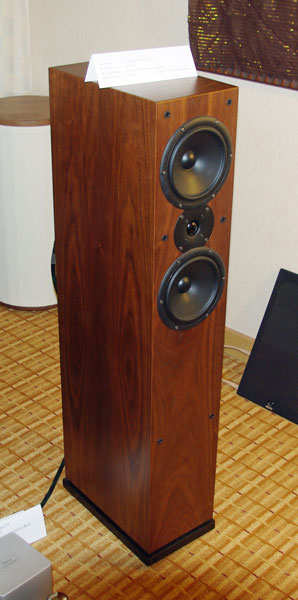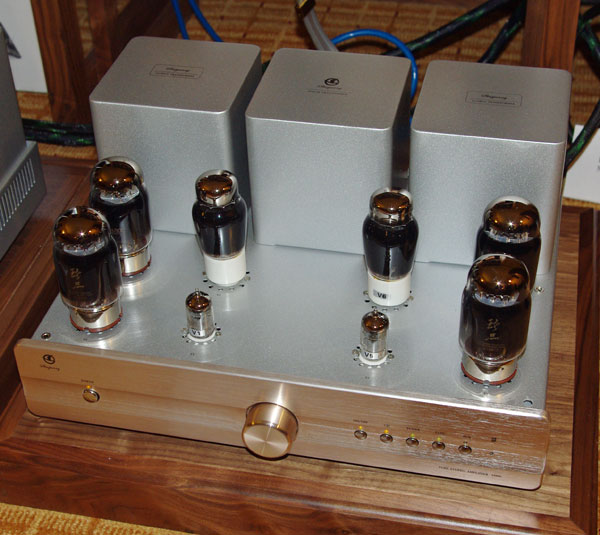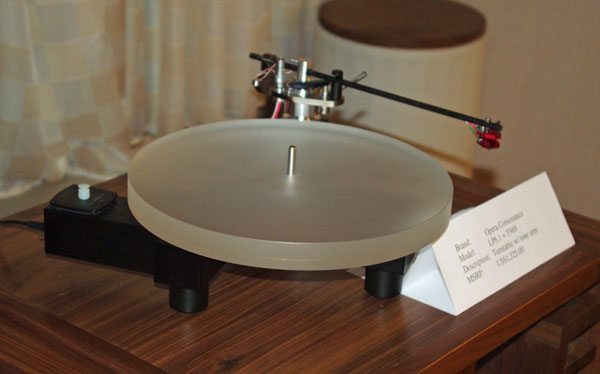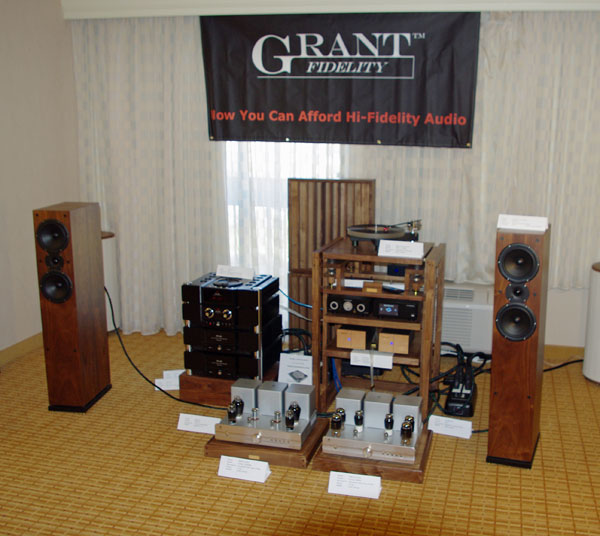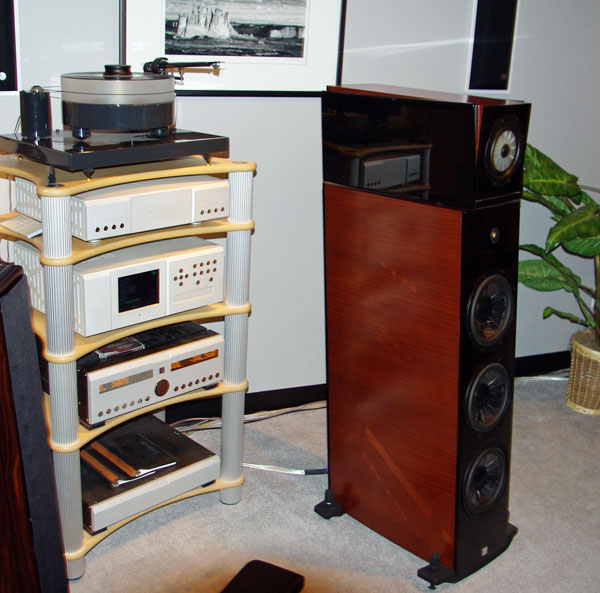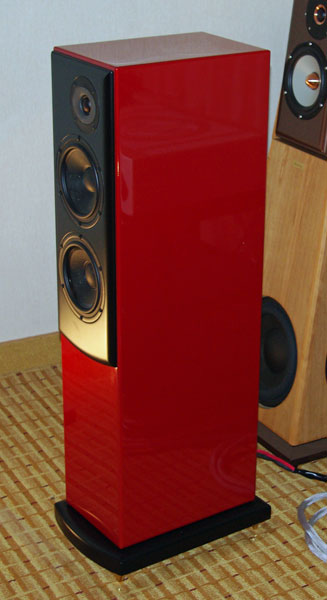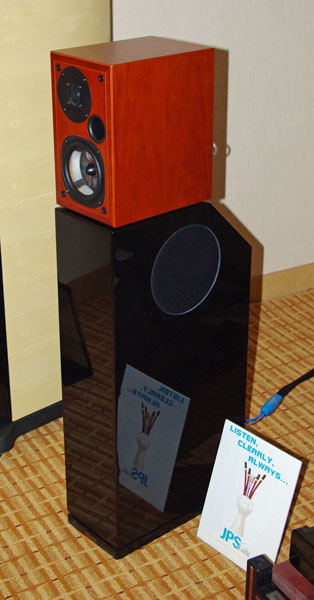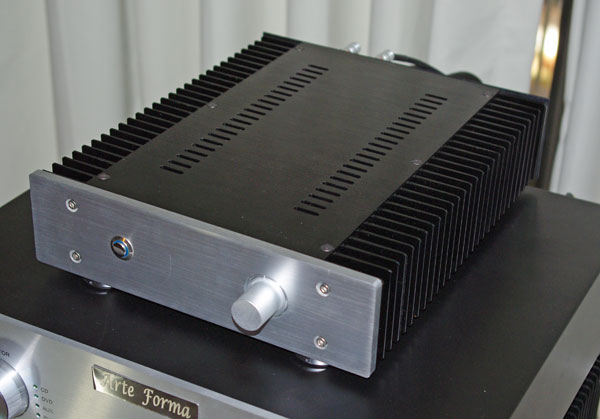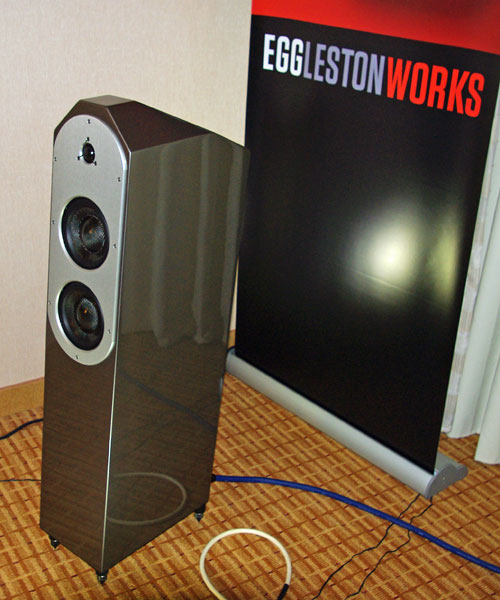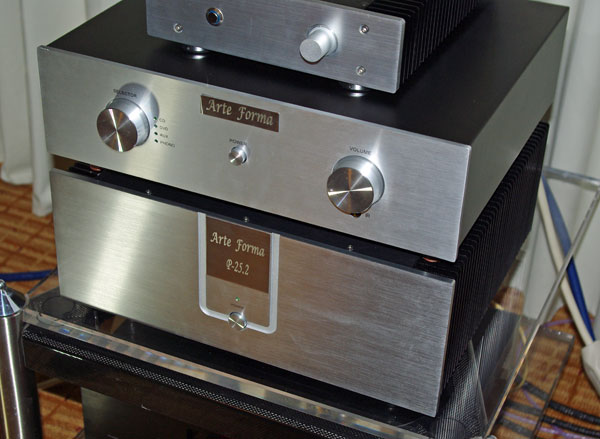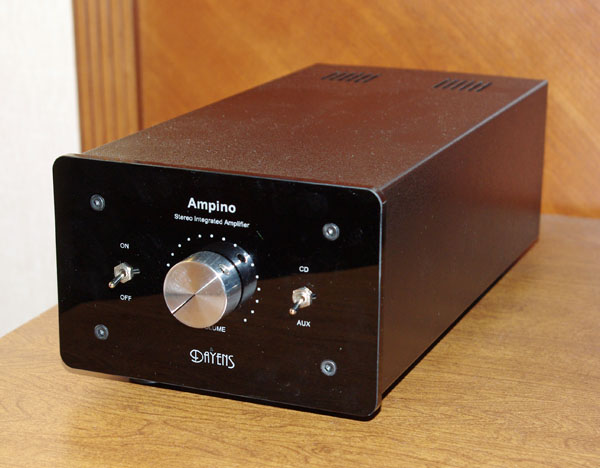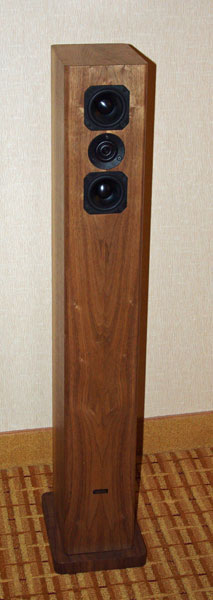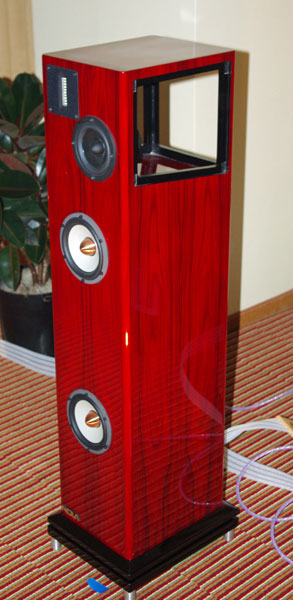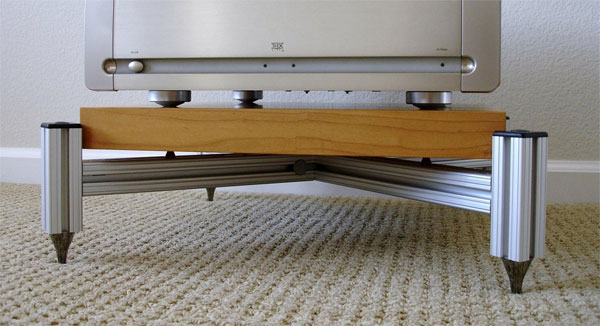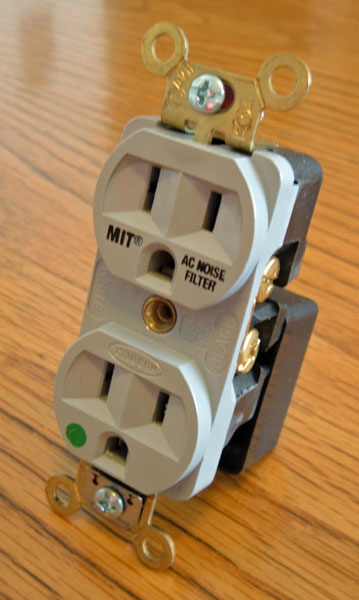|
You are reading the older HTML site
Positive Feedback
ISSUE
52
Rocky Mountain Audio Fest 2010
Once again, I had a great time at RMAF. I saw friends, renewed acquaintances, and met new people. I listened to a lot of interesting audio equipment and some great music. Overall, I could not want for anything more from the whole experience, which is a measure of how adept and efficient the Colorado Audio Society has gotten at organizing this event. I have no actual figures but subjectively this year's show seemed much busier than 2009's. The eleventh floor of the tower building was added this year so there were definitely more exhibitors. Big names like Sony, Musical Fidelity, Rogue, and NAD had a presence this year as well. I think that reflects how important the show has become. www.audiofest.nett I began with a list of equipment and people that I wanted to see and then let serendipity carry me through the rest of the show. While I concentrated on affordable equipment, there were some unaffordable items too interesting to resist. What follows is my idiosyncratic trip through RMAF 2010 and what I found interesting enough to want to tell PFO readers about.
Sjofn HiFi showed their new "The Clue" loudspeaker for the first time at RMAF. The Clue's outward appearance is that of a fairly typical two-way mini-monitor but its classic size and shape hides some very sophisticated engineering and some even more radical thinking. In fact, the shape and size of the enclosure, along with its room placement and stand height, are integral to its outstanding performance. The Clue's 5.5 inch woofer/midrange driver is a proprietary design made for Sjofn by Scan Speak. It performs its tasks in a vented enclosure. The tweeter comes from Vifa. These drivers have been chosen for their similar sound characteristics, despite being from two different companies. The Clue measures 14 by 8 by 10.5 inches (HWD) and weighs 16.5 pounds. It is rated at 86.5dB efficiency and a nominal 4.2 Ohm impedance. The Clue sells for $1500 per pair direct from Sjofn HiFi. The Clue's designer, James Croft, filled me in on some of the engineering and thinking that went into its design. The Clue needs to sit on stands 20-22 inches in height. It is designed for placement within 2 inches of the rear wall, toed-in toward the listening position. This near-wall placement is designed to provide room reinforcement for the woofer at the point where its acoustic output starts rolling off. The Clue gains 3dB of reinforcement from the floor, the wall behind it, and from mutual coupling—for a total of 9dB. This results in bass output all the way down to 28-33Hz, depending upon the room. (And, I might add, this is real bass. I experienced The Clue's low end and it is hard to believe that that sort of output is coming from such a small enclosure.) The Vifa silk dome tweeter has output up to 32kHz. It sits behind an acoustic lens that is machined to military tolerances. This lens works to spread the tweeter's output over a wide area at the same time that the woofer starts to become directional as it approaches its 2.8kHz crossover frequency. The result is an extremely large and consistent listening area. I heard The Clue from numerous positions within Sjofn's listening room as well as from center position. While sitting right in the center does sound best, there is surprisingly little change even when positioned pretty much directly in front of one of the speakers. For normal listening room use, The Clue will offer an unusually wide sweet spot. No matter what position I listened from, there was always good center fill and a solid placement of voices and instruments within the soundstage. The treble output was exceptionally clean and detailed, voices were lovely, and the bass, as noted, was remarkable. The Clue will also play very loudly without any apparent effort. Listening to The Clue, I found myself considerably impressed by its full-range frequency response. Lars Erickson of Sjofn HiFi made the point that where the performance of The Clue was concerned, only the best parts available were used. Keeping the cabinets simple—forgoing curved side panels, for example—and selling direct help to keep the price down. The Clue is offered in gloss black, cherry, and maple. I will be getting a pair for review fairly soon, something I am definitely looking forward to. The Von Schweikert VR-33
"For the first time ever, own a $15,000 speaker for only $3,750," states the Von Schweikert brochure. This statement certainly got my attention and that of a lot of other audiophiles in Denver. The Von Schweikert VR-33 was new to RMAF. Like The Clue it is designed for near-wall placement and sold factory direct. At a reasonable $3750, it generated a lot of interest, some of which undoubtedly stemmed from the fact that a pair was being raffled off during the show! The VR-33 is a vented, three-way MTM design with rear-firing woofer; it stands 50 inches tall, 16 inches wide at the rear, and 12 inches deep. Its cross section is trapezoidal. Because it is designed for placement within a few inches of the rear wall, VS claims that the VR-33 "can be successfully used in any room, regardless of size or shape." It is 90dB efficient allowing most quality amplifiers, tube or solid state, to easily drive it and is made to be single-wired, minimizing the cost of speaker cabling. Claimed frequency response is 30-30kHz with an 8 Ohm impedance. To keep costs low, the VR-33 is made of high density mdf. It is very solidly constructed; each speaker weighs 103 pounds! To keep cabinet costs low, the usual high-quality VS veneering is replaced with a knit body stocking. Personally, I find this very attractive. There is a very nicely finished wood top and bottom plinth with spikes. VS offers a 90 day home trial so that listeners can hear the VR-33 with their own electronics and in their own room. The VR-33 room was so busy every time I was in it, that getting any feel for the speaker's sound quality was virtually impossible. At the same time, I, like everyone else, was excited by the fact that here was a VS speaker that I could conceivably afford! Follow this link to John Zurek's review of the VR-33 in PFO 50. https://positive-feedback.com/Issue50/vonschweikert_jolida.htm The Von Schweikert VR-35 Export Deluxe speaker At first glance, the Von Schweikert VR-35 appears to be a silver version of the VR-33. I ventured into the Musical Reality room and was met by Cor Dekker, who is the VS representative for the Benelux countries of Europe. He explained that he was going to be selling VS speakers in Europe along with the other lines that he represents. The system Cor had assembled to drive the VR-35s consisted of an Eera CD player from France, which retails for $12,000.
It was feeding a KR "Kronzilla" SX1 MKII hybrid integrated amplifier. With its two enormous tubes, the KR amp immediately got my attention.
Each of the tubes is a T 610, which is a pair of 300B tubes in one glass bottle. These tubes are huge and run hot. They, in turn, feed a 50 WPC Mosfet driver stage. The Kronzilla sells for $19,000. Cor informed me that a "Green Line" version of the Kronzilla will be offered in 2011. It will differ from the current amplifier in having separable tube and solid state sections. For casual listening the T 610 tubes can be turned off using just the Mosfet amplifier section. For serious listening, the tubes can be reignited. With tubes this large, most of us would wonder just what the cost of re-tubing will be, so I asked. Cor said that an example of the T 610 has been running 24/7 at the KR factory for over 15 years and still meets its specifications. He estimated that the T 610 in the Kronzilla will last for 40-50 years in normal use. It was a relief to hear that re-tubing would not be on my bucket list, assuming I could afford a Kronzilla in the first place. At this point, Albert Von Schweikert himself came into the room, sat down next to me, and began telling me about the VR-35 speakers. I was flattered that he took the time to talk with me and impressed by his enthusiasm for his creation.
The VR-35 is the same size as the VR-33. Unlike the VR-33, it is constructed of MDF bonded to granite, which is lined with felt, then filled with poly fiber. AVS showed me a sample of this enclosure construction and it is, quite literally, deader than my driveway. Each VR-35 weighs in at 115 pounds. In addition to the construction differences, the VR-35s also have upgraded parts over the VR-33 and are bi-wireable/bi-ampable. A pair sells for $7995. I had the chance to listen to this system at length and I would have happily brought it home with me. Just getting the chance to hear a system like this justifies, for me at least, making the trip to RMAF. Aperion Audio Verus™ Grand Towers
Aperion Audio is another speaker line that is sold factory direct. They offer a 30 day home trial for all of their products. While primarily a home theater line, the 92dB efficient Verus™ Grand Tower speakers will work very well in a two-channel set-up. I was impressed by the obvious quality of the Grand Towers. At 42 inches high and 65 pounds apiece, they appear to offer a lot speaker for their $1798/pair price. The more so, since several of their drivers are proprietary designs. The Grand Towers are bi-wireable/bi-ampable and come in both gloss black and cherry finishes. The sound under show conditions was very good. Naim S400 Ovator
Naim showed their S400 Ovator speaker, the little brother to the S600 shown last year. The S400 is still a large speaker but brings the price of owning a pair of Ovators down to $5250 to $5750 depending upon the finish, about half that of the S600. The pair at RMAF was the only pair in the US at the time. Musical Fidelity I have never heard any Musical Fidelity components. I am not sure how that has been possible, but I wanted to take advantage of their showing at RMAF to finally get some insight as to how MF equipment sounds. I had a chance to listen to the top-of-the-line AMS CD player (Anthony Michaelson Signature), the Primo preamplifier, and the AMS 50 Class A amplifier. It turns out that MF equipment sounds extremely good when played through a pair of Verity Audio Amadis loudspeakers. Here was another system that I would have happily taken home. I still think of myself as mostly a tube-guy, although I have been waffling somewhat lately, but what I have heard of Class A leads me to feel that it has most of what I like about tubes without having to deal with the tubes themselves. As a tree-hugger, I have some problems with the amount of electricity Class A wastes but I think I could even reconcile myself to that, with a little effort, in view of the sound quality. Grant Fidelity
Grant Fidelity always has interesting new components and accessories to listen to at RMAF. My first trip through their room gave me a chance to hear the M-700A Compact Cyclone speakers. These two-way floor standers use Vifa drivers, feature wood veneers, and cost only $1250 per pair shipped. They sounded very good with all the different equipment that I got to hear driving them.
Initially, the power source for the Cyclones was a Shuguang KT-88 integrated amplifier. Rated at 45 WPC and costing $1600, it sounded very good with vinyl played on an Opera Consonance turntable, $1325 including arm.
(GF also showed a Shuguang 300B integrated amplifier. It looks virtually identical to the KT-88 model. Using two 300Bs per channel is generates 9-watts per channel. Retail price is only $2100.) The phono section in use was the Opera Consonance PM-2 MKII, MM/MC retailing for $1450.
My second trip to the GF room found me listening, once again, primarily to vinyl but this time played through a Shengya CV-1 balanced tube preamplifier ($3200) and PSM-100 mono Class A amplifiers ($3200 per pair). The M-700A speakers were still in use and reflected this system's more detailed and considerably more powerful capabilities. The Shengya components are just to the right of the left speaker in the photo. Note the slatted structures in the rear of the room. These diffuser panels are referred to by Grand Fidelity as "Image Stabilizers." They measure approximately 24-inches high by 21 inches wide by 5 inches deep. With the panels centered behind and between the speakers, the imaging was more solid, more textured, and just simply richer and more realistic. With the panels removed, the sound was still very good but seemed slightly faded by comparison. The interesting thing to me was how easy it was to hear the change in sound quality with the panels in and out of position. It was not subtle. No one who was in the room with me failed to hear the difference. The theory behind these panels is that they block reflections from the rear wall that interfere with the opposite channel speaker and cause image smearing. The room's acoustics have less effect on each channel's output as a result. Grant Fidelity will be offering these panels for sale and suggested retail is around $300 each. (Most listeners will probably need two.) Given that they are made of American walnut, the price seems exceedingly reasonable. I asked Ian Grant to send a pair for me to review (and keep). As has become the norm, Grant Fidelity keeps offering audio equipment at just about every price point and, at each point, it is extraordinarily good sounding. A Visit to Soundings I was chatting with Mark Krekeler of Denver audio dealer Soundings on Friday morning and he invited me to a reception that evening at their store. Soundings is located only a couple of blocks from the Marriott where RMAF is held so my wife and I enjoyed the wonderful fall Denver evening as we hoofed it from our hotel to their store. We got to enjoy an evening that included very good wine, bruschetta, and superb sound. Soundings main listening room houses several systems. In use when we arrived was a pair of Vienna Acoustics Klimt The Kiss speakers driven by Boulder components. This set-up sounded incredible and my wife found it hard to believe that the four small boxes comprising The Kiss speakers could fill the entire room so realistically. It was the first time I had heard The Kiss speakers and I was similarly impressed.
There were numerous requests to hear the big system in this room, however, a pair of Vienna Acoustics The Music speakers, also powered by Boulder electronics. As a semi-professional audio writer, it is my job to describe what I hear for the benefit of my readers. I was left pretty much wordless by this system, though. It was the best system I have ever heard. This was due to two things—superb components and equally superb set up. After blowing every one away with The Music/Boulder system, Rod Tomson, Sounding's owner, spoke about the importance of proper speaker location. Rod is an expert on Sumiko Master Set™ speaker positioning. He attributed a large proportion of the quality of what we had heard to optimal speaker placement. In the right position, the speakers simply do not fight the room. "Loud" as a quality of the system ceases to exist. You have only volume and you find yourself listening much louder than you realize, simply because the music is so realistic and the distortions of improper set-up are eliminated. I found what he had to say very illuminating and actually reassuring. Some of the anomalies that I have run into in my own room made absolute sense as Rod discussed the problems inherent in getting speakers properly located. I took with me a copy of the Master Set™ white paper that Rod has written and plan to do more research on the subject. Based on what I heard at Soundings, the Master Set™ system obviously works very well. My wife and I had a very enjoyable and, as it turned out, educational evening at Soundings and want to thank everyone there for their warmth and hospitality. Bamberg Engineering
Steve Fay is one of the really nice people that I always enjoy chatting with at Rocky Mountain but never have the opportunity to actually sit down and talk with. This is a result of the fact that the Bamberg room is always extremely busy. This year, when I visited their room, Bamberg Engineering was demonstrating their Series 2 TMM speakers with Modwright electronics. The Series 2 is the smaller partner to the Series 5 TMW and a very nicely sized speaker for most domestic listening rooms. It is offered in a choice of five paint finishes at $4800 per pair (as shown) or two veneers at $4000 per pair. The Series 2 TMM is rated at 88.6dB efficient and a four Ohm load. A two and a half way design, the lower woofer is rolled off early, leaving essentially a two way speaker over the midrange and treble. A pair of passive "drones" reinforces the bass. Bamberg claims that no sub is needed. The drone output is specified as -6dB at 36Hz. A fourth-order Linkwitz-Riley crossover alignment is used, crossing over at 2.4kHz. The Series 2's standard set up is single-wired but a bi-wired option is available. The series 2 TMM is approximately 43 inches high, 11 inches wide, and 16 inches deep. Each speaker weighs 63 pounds. They are very attractive speakers. The Bamberg room was among the best sounding rooms that I encountered at RMAF. Plans are afoot to do a review of the Series 2 speakers. Usher I promised a friend of mine that I would listen to the Usher Be-718 loudspeaker and let him know what I thought of it. Unfortunately, the Be-718 wasn't being shown at Rocky Mountain. What was being demonstrated was, in its own right, equally interesting.
Usher was demonstrating their SW-520 mini-monitor/subwoofer system. The two-way monitor speakers (5-inch woofer/mid, 1-inch tweeter) sell for only $479 per pair and a pair of the 7-inch sub/stands for only $899 more. The total for this system is a mere $1378. While small, it is not a cheapened or under-built set up. Each of the subs weighs 77 pounds! These speakers are of simple layout and construction but very high quality. I found the sound quality of this system to be extremely good. Paired with an amp like the Shuguang KT-88 integrated, I think it would be absolute bliss. Definitely worth checking out. Arte Forma I met Mike Gill of Arte Forma Audio and his designer, Norman Yang, last year at Rocky Mountain. They were showing an expensive high-sensitivity horn speaker system and a mid-priced SET tube amplifier. This year they were back with all solid state components. Arte Forma manufactures their equipment in Taiwan. Their line is fairly extensive and growing. They brought two integrated amps, a preamp, power amp, and monitor speakers to RMAF.
The product that I found most interesting was their $799 120WPC USB integrated. This compact (10 x 12 x 3 inch WDH) but heavy amplifier is designed for direct connection to the USB output of a computer or other source. It has a built-in 24/96 DAC. In a system consisting of an Esoteric front end and Eggleston Works Fontaine II SE speakers ($7500 per pair), it sounded very good. A 60WPC version of this amplifier is in the works and it will retail for only $599.
I also got the chance to hear Arte Forma's four-input line stage preamplifier ($2000) with their 250 WPC P25.2 power amp (also $2000). This system was very impressive with excellent bass, very good imaging, and very satisfying overall balance. The fit and finish was also to a very high standard.
I am planning on reviewing the Arte Forma 150WPC, $2000 integrated amplifier at some point. It looks just like the preamp and uses Mundorf capacitors in its circuitry. Norburt Mundorf actually helped with its voicing. It should be very interesting.
Arte Forma is also an importer for the Serbian Dayens Audio line consisting of several integrated amplifiers and speakers. The Dayens Alpino integrated amplifier was on static display. It is a 25WPC integrated with separate monobloc amplifiers internally. A pair of actual monobloc amps is in the works with prices yet to be determined.
I did get to hear the $1,999 per pair Dayens tower speakers utilizing a pair of 3-inch full-range drivers plus tweeter. Playing a Diana Krall CD, the midrange was very smooth and realistic and the bass was deeper than I would have expected. The fit and finish of the speaker cabinet was excellent. Here are yet more very good sounding, high-quality affordable products. We truly do live in blessed times in terms of audio equipment. Nola Speakers
There is always excellent sound in the Nola room and this year was no exception. I spent some time listening and it was hard to make myself get back to work. While the $25,000 per pair Nola Grand Reference speakers don't fall within the realm of equipment that I review, they are so stunningly beautiful, that I had to take a photo of them. DKM Design
The only thing I purchased this year at RMAF, other than some SACDs and CDs, was as an amplifier stand made by Martin H. Conley of DKM Designs ($389.99). Martin's stands were in use in several rooms, notably the Von Schweikert VR-33 room and the Fritz Speaker/Modwright/GIK Acoustics/DKM room. (Martin makes a dedicated stand for the Fritz Carbon 7 monitors.) I like the simplicity of Martin's design and thought an upgrade amplifier stand would be an interesting improvement for my system. I will report on what I hear as soon as I can. MIT Cables
As I was getting ready to leave Denver on Sunday morning, I got a phone call from Gavin Fish, Global Sales Manager of MIT. I had spoken with Gavin about doing a review of their AVt Speaker Modules. These little boxes bring the benefits of MIT's Interface Technologies to ordinary speaker wire. A pair sells for $200 and a review will be forthcoming. The reason he called, however, was to let me know that I had won a Z Duplex outlet in their show raffle! I stopped by MIT's room and picked up my prize; I will be writing about it when I do the AVt review. I will be putting the outlet on a dedicated line used by my front-end components where its noise reducing filters can be put to good use. The results should very interesting. Not only did I enjoy myself at Rocky Mountain, but, as I have noted, I left Denver with plans for reviewing a number of very interesting components. I should have no problem staying busy over the winter. And then there is my trick outlet. It felt great to leave Denver a winner.
|

